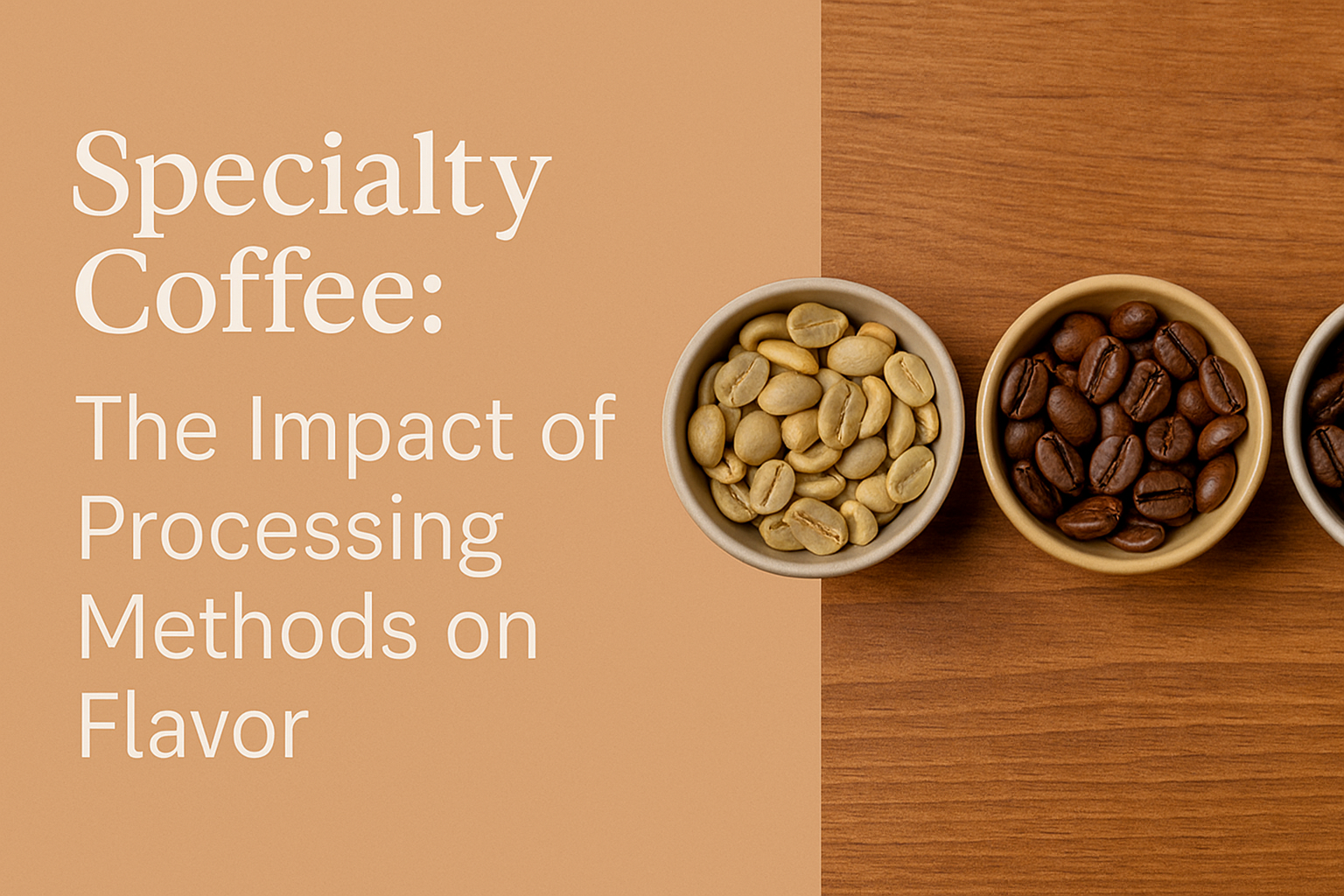In specialty coffee, one of the most powerful factors influencing a coffee’s flavor isn’t just the origin, altitude, or varietal — it’s the processing method.
This crucial step happens between harvesting and drying, and it directly shapes the sweetness, acidity, mouthfeel, and overall complexity of the final cup.
For baristas and coffee professionals, understanding processing methods is essential. It helps you interpret flavor profiles, select the right brewing approach, and explain to customers why a natural Ethiopian tastes so different from a washed Colombian — even if they’re roasted the same.
Let’s break down the major coffee processing methods and explore how each one impacts what you taste in the cup.
What Is Coffee Processing?
After coffee cherries are harvested, they need to be processed — that means removing the layers of fruit that surround the seed (what we call the bean). This must be done carefully to prevent fermentation, mold, or flavor defects.
The way a producer removes the skin, mucilage, and parchment from the coffee affects the bean’s chemical composition and moisture level, which in turn influence:
- Flavor
- Acidity
- Sweetness
- Body
- Cleanliness
The three most common processing methods are washed, natural, and honey — though there are many variations and experimental styles emerging.
1. Washed (Wet) Process
This is the most common method in specialty coffee and is often preferred for its clarity and brightness.
How It Works
- Cherries are depulped (outer skin removed)
- Beans are fermented in water to break down mucilage
- Beans are washed clean and dried
Flavor Impact
- Clean and crisp cup
- Bright acidity
- Clear flavor notes
- Less body, more transparency
Regions That Use It
- Colombia
- Kenya
- Guatemala
- Ethiopia (in washed lots)
Ideal Brew Methods
- Pour-over
- Chemex
- Espresso (for clean and elegant shots)
As a Barista
Washed coffees are perfect when you want to highlight the origin. They often taste citrusy, floral, or tea-like — and benefit from precise extraction.
2. Natural (Dry) Process
One of the oldest methods, naturals are gaining popularity in the specialty scene for their bold, fruity profiles.
How It Works
- Whole cherries are dried in the sun
- The fruit ferments around the bean
- Once dried, the skin and pulp are removed
Flavor Impact
- Fruity and sweet
- Wine-like or fermented notes
- Heavy body
- Sometimes inconsistent if not well-managed
Regions That Use It
- Ethiopia
- Brazil
- Yemen
Ideal Brew Methods
- French press
- AeroPress
- Espresso (for fruit-forward shots)
- Cold brew
As a Barista
Natural coffees are vibrant and expressive, but can be polarizing. Use them to create standout filter brews or adventurous espresso drinks. Always dial in carefully to avoid muddiness or overpowering fermentation.
3. Honey (Semi-Washed) Process
A hybrid between washed and natural, honey process is popular in Central America.
How It Works
- Cherries are depulped, but some mucilage is left on
- Beans are dried with the sticky layer still attached
- No fermentation tanks or full washing
Honey processes come in variations:
- Yellow honey: minimal mucilage
- Red honey: moderate mucilage
- Black honey: most mucilage retained
Flavor Impact
- Balanced cup with sweetness and clarity
- Rounded acidity
- Medium to full body
- Notes of honey, brown sugar, red fruit
Regions That Use It
- Costa Rica
- El Salvador
- Honduras
Ideal Brew Methods
- Pour-over
- Espresso
- Immersion brews
As a Barista
Honey-processed coffees offer versatility. They’re great when you want more sweetness than a washed coffee but more control than a natural. They also pair well with milk.
Other Experimental Methods
The specialty coffee world is full of innovation. Some producers are now exploring experimental fermentation techniques to create new flavor profiles.
Examples Include
- Anaerobic fermentation: Beans fermented in oxygen-free tanks, often producing funky, tropical, or spiced notes
- Carbonic maceration: Borrowed from winemaking, results in juicy, complex flavors
- Lactic fermentation: Introduces lactic acid bacteria for creaminess and acidity
These methods often result in wild and unique coffees, ideal for competitions or limited edition brews.
As a barista, it’s important to understand that these methods can produce surprising flavors — not always crowd-pleasers, but perfect for adventurous customers.
How Processing Affects Brewing
Processing affects how a coffee grinds, extracts, and behaves in brewing.
- Washed coffees are more uniform and predictable
- Naturals can be more fragile or inconsistent
- Honeys often require fine-tuning of grind size and brew time
When brewing:
- Use finer grind for washed to extract bright flavors
- Use coarser grind for naturals to avoid over-extraction
- Adjust dose and brew time for honeys to balance sweetness
Always cup a new coffee before using it in service, especially if it’s a natural or experimental process.
Talking to Customers About Processing
Most customers don’t know what “honey-processed” means — but they can taste the difference.
Use simple language:
- “This is a washed coffee — it’s bright and clean, with citrus and floral notes.”
- “This one’s a natural — expect bold fruit flavors, like berries and wine.”
- “The honey process gives this coffee extra sweetness and a smooth finish.”
Helping customers understand how flavor is shaped at the farm level deepens their appreciation and gives you an opportunity to educate without overwhelming.
Processing and Sustainability
Some methods are also more environmentally sustainable than others.
- Washed processing uses a lot of water and can strain local resources if not managed properly
- Natural processing uses less water but requires ideal weather conditions
- Honey sits in the middle — efficient, but labor-intensive
Many producers are innovating with eco-friendly fermentation or water-saving equipment. As a barista, supporting sustainable processing practices shows that you value the people and environment behind the coffee.
Final Thoughts: Processing Is Flavor’s Foundation
Understanding processing methods helps you connect the dots between farm and flavor. It’s what makes a coffee taste like tropical fruit or crisp apple. It’s why one coffee is syrupy and another is clean and light.
As a barista, knowing how a coffee was processed helps you:
- Choose appropriate brew methods
- Adjust your recipe for balance
- Explain flavor to customers with confidence
- Appreciate the farmer’s craft
So next time you taste something wild, sweet, or clean — ask yourself: was it the origin, the roast, or the process?
Chances are, it was all three. But the process might be the biggest clue of all.

Marcelo Rodrigues is a passionate barista with over 7 years of experience in specialty coffee. He’s worked in top cafés, led barista training sessions, and now shares practical tips to help beginners and coffee lovers improve their skills. Through this blog, Marcel makes the world of coffee more accessible—one cup at a time.

